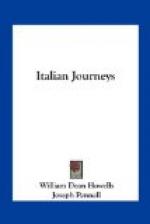It may give an idea of the Italian way of doing things to say that, as we understood, this break in the line was only a few miles in extent, that trains could have approached both to and from Bologna, and that a little enterprise on the part of the company could have passed travellers from one side to the other with very small trouble or delay. But the railway company was as much daunted by the inundation as a peasant going to market, and for two months after the accident no trains carried passengers from one city to the other. No doubt, however, the line was under process of very solid repair meanwhile.
For the present the only means of getting to Bologna was by carriage on the old highway, and accordingly we took passage thither in the omnibus of the Stella d’Oro.
There was little to interest us in the country over which we rode. It is perfectly flat, and I suppose the reader knows what quantities of hemp and flax are raised there. The land seems poorer than in Lombardy, and the farm-houses and peasants’ cottages are small and mean, though the peasants themselves, when we met them, looked well fed, and were certainly well clad. The landscape lay soaking in a dreary drizzle the whole way, and the town of Cento when we reached it, seemed miserably conscious of being too wet and dirty to go in-doors, and was loitering about in the rain. Our arrival gave the poor little place a sensation, for I think such a thing as an omnibus had not been seen there since the railway of Bologna and Ferrara was built. We went into the principal caffe to lunch,—a caffe much too large for Cento, with immense red-leather cushioned sofas, and a cold, forlorn air of half-starved gentility, a clean, high-roofed caffe and a breezy,—and thither the youthful nobility and gentry of the place followed us, and ordered a cup of coffee, that they might sit down and give us the pleasure of their distinguished company. They put on their very finest manners, and took their most captivating attitudes for the ladies’ sake; and the gentlemen of our party fancied that it was for them these young men began to discuss the Roman question. How loud they were, and how earnest! And how often they consulted the newspapers of the caffe! (Older newspapers I never saw off a canal-boat.) I may tire some time of the artless vanity of the young Italians, so innocent, so amiable, so transparent, but I think I never shall.
The great painter Guercino was born at Cento, and they have a noble and beautiful statue of him in the piazza, which the town caused to be erected from contributions by all the citizens. Formerly his house was kept for a show to the public; it was full of the pictures of the painter and many mementos of him; but recently the paintings have been taken to the gallery, and the house is now closed. The gallery is, consequently, one of the richest second-rate galleries in Italy, and one may spend much longer time in it than we gave, with great profit. There are some most interesting heads of Christ, painted, as Guercino always painted the Saviour, with a great degree of humanity in the face. It is an excellent countenance, and full of sweet dignity, but quite different from the conventional face of Christ.




